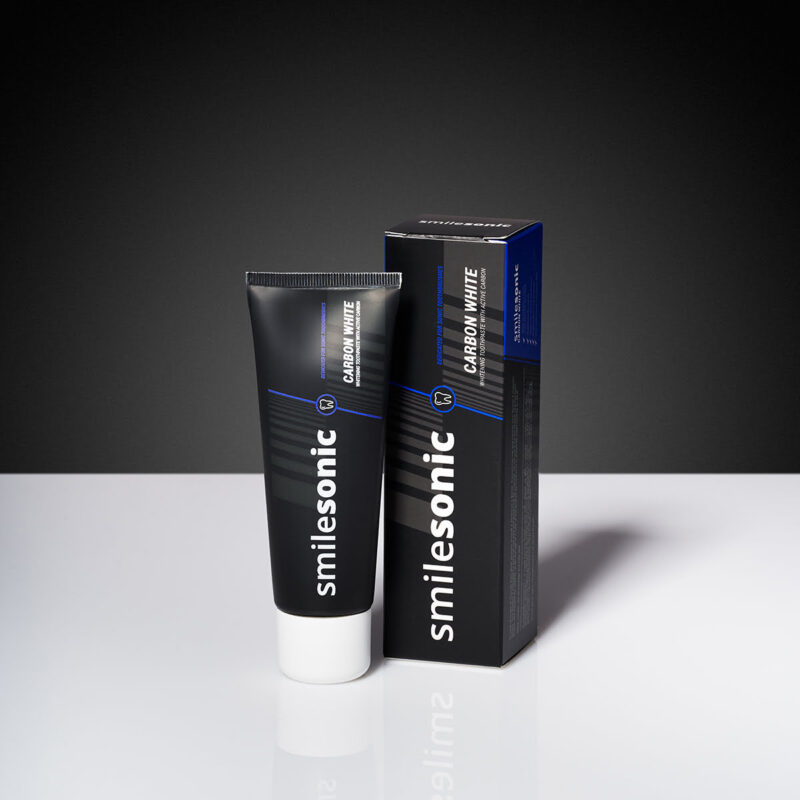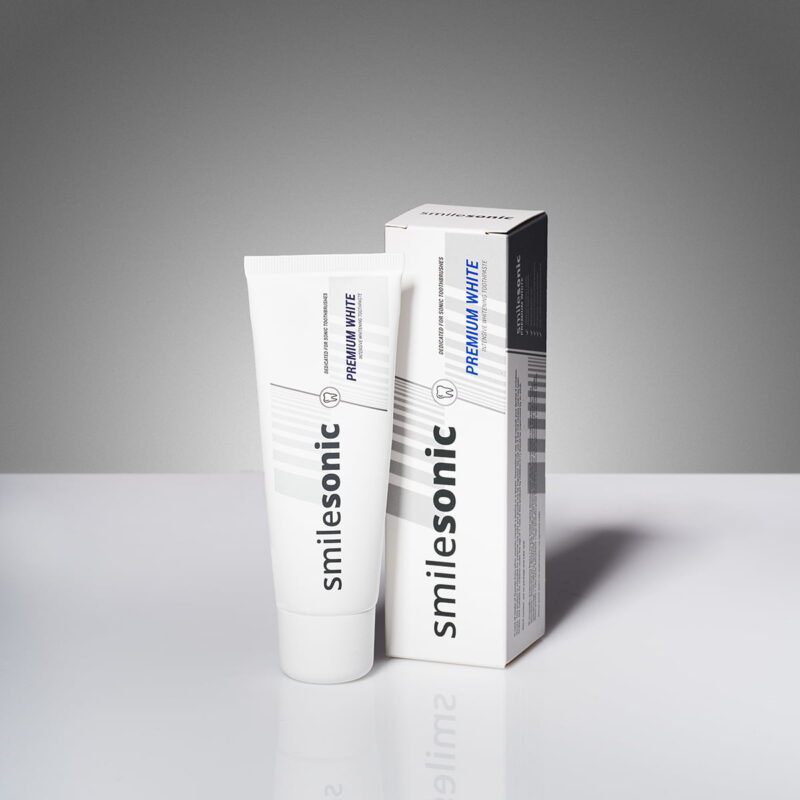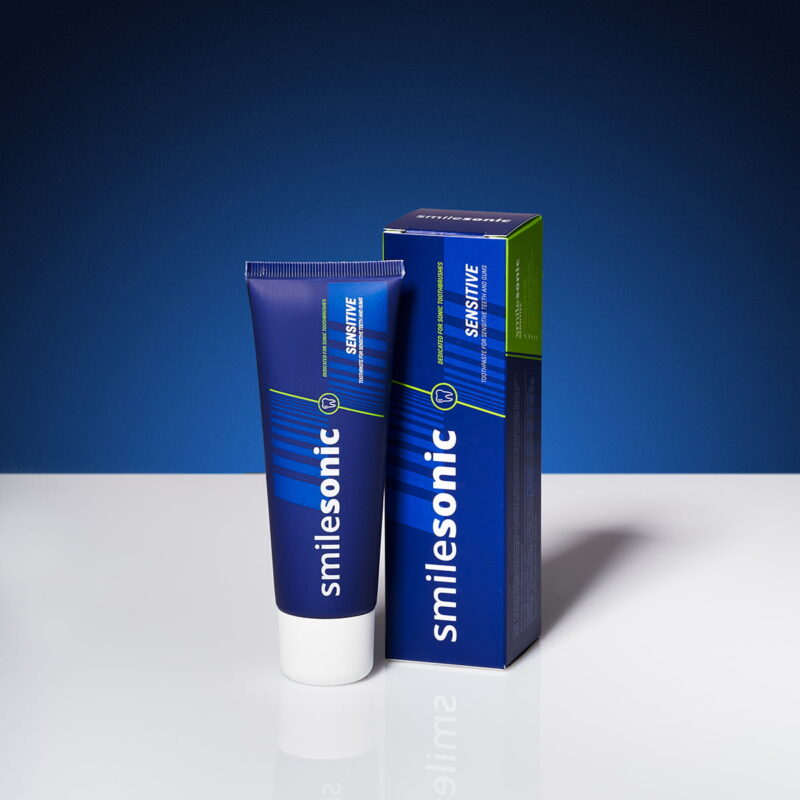Smilesonic toothpastes
Showing all 3 results
Smilesonic Carbon White toothpaste
39,00 złSmilesonic Premium White toothpaste
39,00 złSmilesonic Sensitive toothpaste
39,00 zł
It would be difficult to imagine everyday oral hygiene without toothpaste. It has become a very important element of the whole hygiene process, as it helps clean enamel surface, restores the natural whiteness of the teeth and refreshes breath. Toothpastes for sonic toothbrushes also protect against gum diseases. They feature numerous ingredients with antibacterial, cleaning, anti-inflammatory, whitening or refreshing properties. They come in the form of classic toothpaste or gel.
We can distinguish several types of toothpaste for sonic toothbrushes, focusing on their effects and properties, e.g., toothpaste against caries, whitening toothpaste, and remineralising or antibacterial toothpaste. The choice of the right product depends on the individual needs of every person. If you would like to focus on achieving a snow-white smile, you should select whitening toothpaste. If your primary goal is to protect your teeth against caries – select the one with remineralising properties. When it comes to inflammation and bleeding gums, antibacterial and anti-inflammatory toothpaste will prove the most useful as it includes valuable plant extracts and chlorhexidine.
Toothpaste types
What toothpaste should you choose? Which one will be the best? Before you find the answers to these questions, ask yourself – “what do my teeth and gums really need?”. The choice of the right preparation is a very personal matter. Familiarise yourself with the properties o different toothpaste types.
- natural toothpaste – its formula is based on natural plant ingredients. It does not include parabens, artificial dyes, SLS, paraffin, or other harmful substances. Natural agents for oral care have anti-caries effects, and they provide fresh breath for a longer time. Due to the lack of elements that strengthen the enamel, it is worth to use other toothpaste types as well.
- fluoride-free toothpaste – this term is often searched for by users. More people every year look for products where fluoride has been replaced with xylitol or hydroxyapatite. However, we should not worry about products that feature safe doses of fluoride.
- refreshing toothpaste – it features substances that combat the volatile sulfur compounds that are responsible for bad breath. Toothpastes of this type feature mint oils that provide freshness in the oral cavity for a longer time. They also regulate bacterial flora and limit the development of bacteria
- anti-caries toothpaste – designed for everyday use, it may contain fluoride hydroxyapatite or xylitol. It protects the enamel against bacteria, balances the pH in the oral cavity, and has cleaning properties. The addition of fluoride in these toothpastes for adults should not exceed the level of 1450 ppm; for children the dose should not be higher than 1000 ppm.
- Remineralising toothpaste – its main purpose is to strengthen and rebuild the enamel, and it uses fluoride and hydroxyapatite to do it effectively. Thanks to this combination, it is possible to remineralise and protect the enamel against the effects of acids and bacteria. If you use this type of toothpaste for a sonic toothbrush, you may expect the pain associated with teeth hypersensitivity to disappear soon, and plaque may accumulate more slowly.
- Whitening toothpaste – it removes discolouration and sediments that are present on enamel surface, restoring the natural whiteness of teeth. The whitening occurs via thorough mechanical abrasion. Whitening toothpastes include abrasive particles that polish the teeth. Some of them might also be recommended to those that suffer from hypersensitive teeth or gums. Whitening toothpastes and gel with the addition of carbamide peroxide may whiten the teeth by even a few tones.
- antibacterial toothpaste – agents of this type are based on herbal extracts and chlorhexidine. They effectively inhibit the development of bacteria that cause illnesses, protecting against inflammations and bleeding. They are also recommended for use after surgeries conducted in the oral cavity, as well as when treating gum diseases.
- toothpaste for hypersensitivity – it includes a bigger dose of fluoride, hydroxyapatite, as well as pain soothing ingredients. It will not solve the problem of hypersensitivity, but it can bring temporary relief. When you use toothpaste of this type, you decrease the risk of developing cavities in the enamel.
- toothpastes for issues with tartar – this type reduces the accumulated plaque through mechanical abrasion or enzymatic dissolution. It also tightens enamel structure. These toothpastes usually include fluoride, hydroxyapatite and chlorhexidine. That last ingredient dissolves plaque.
- toothpaste for dry mouth – it is recommended to those with xerostomia, so the problem of dry mouth, which affects patients after chemotherapy or radiotherapy. Disorders with saliva production may also be associated with drinking too much alcohol or coffee, smoking or staying in air conditioned rooms. Toothpastes for dry mouth should not include any chemical detergents that could dry or irritate mucous membranes.
- toothpaste for children – it may contain fluoride at a level that is appropriate for the specific age group, but it is sometimes replaced by hydroxyapatite. The toothpaste should be free of silicones, SLS and parabens. Toothpaste for the youngest users may be based on natural plant ingredients as well as enzymes that increase the antibacterial protection of the oral cavity against mouth ulcers, thrush or mucous membrane diseases. It is also important for this product type to have a characteristic taste that will encourage the child to brush the teeth more frequently.






